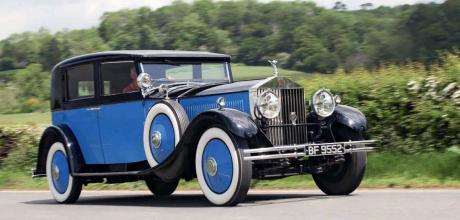1929 Rolls-Royce Phantom I Barker Pullman Limousine
This fabulous Phantom limousine was bought 94 years ago with the proceeds of crime, and has recently been revived after 30 years in a museum. Now it’s a rich reward for its owner-driver – and sometimes transports the luckiest Dachshunds in the country.
WORDS: WILL HOLMAN
PHOTOS: GERARD HUGHES
A HISTORY OF HIGH LIVINGPHANTOM I LIMO VINTAGE CHARISMA
Size, style and a great story to go with it
FEATURE CAR ROLLS-ROYCE PHANTOM I BARKER PULLMAN LIMOUSINE
Considering his initial reaction to this car it’s amazing Chris Spaett bought it at all. ‘I didn’t like the colour, the bumpers or the whitewall tyres,’ says the Herefordshire based classic motorcycle dealer. But two years later he’s racked up nearly 5000 miles in the 1929 Barker Pullman Sports Limousine, which is more than many of us manage in far more modern machinery. It’s also nearly 5000 miles more than the car covered in the previous 30 years, but more on that later.
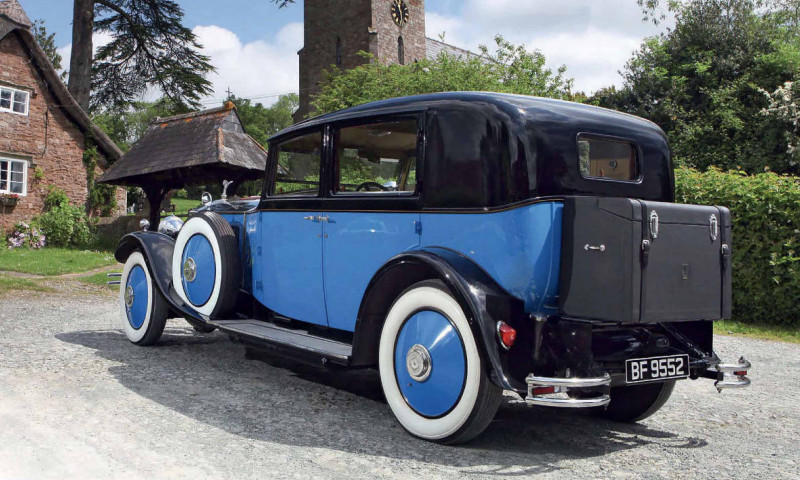
The long-anticipated successor to the Silver Ghost, the New Phantom arrived in 1925. Retrospectively known as the Phantom I, it featured an entirely new overhead-valve, 7668cc, straight-six engine, a unit considerably more powerful than that of its Edwardian predecessor. The New Phantom, like the contemporary 20hp model, also employed a plate clutch rather than the old cone type and adjustable radiator shutters, although its chassis remained largely the same as that of the later four-wheel-braked Ghost, and would continue fundamentally unchanged until the arrival of the Phantom II in 1929. Rolls Royce built 2,212 Phantom I chassis by the time production ceased. Chris’ car, chassis number 42KR, was bodied with sports limousine coachwork by Barker & Co and delivered to its first owner, Captain A C Bowles of London W1 in May 1929. One of the finest of all British coachbuilders and a firm associated with Rolls-Royce from the latter's earliest days, Barker had shown an example of their work to Charles Rolls as early as 1905, who was so impressed that the London-based firm was viewed as the official coachbuilder to Rolls-Royce for the next 25 years.
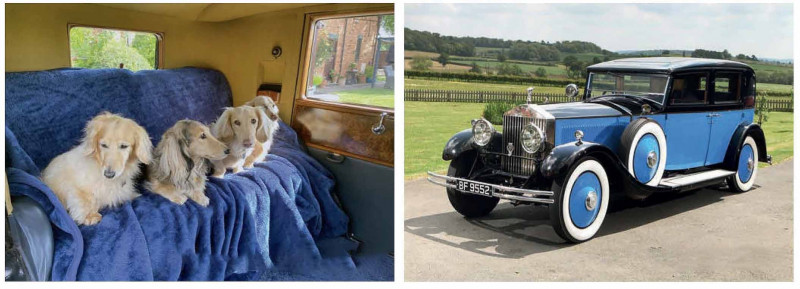
“With nearly 8-litres on tap, there’s so much torque that it will very happily pull from 10 miles an hour in top”
Captain Bowles was a decorated World War I officer who later became embroiled in a financial scam that became a national scandal (see panel on page 43) and he may only have had the car for a few months – in fact it’s possible he never actually took delivery of it, such was the financial mess he found himself in, and the car’s early history becomes as murky as his at this point.
POST-WAR PROGRESS
In 1955 it was bought by Dr M J Russell from Performance Cars of West London for £150. The Russells used the car for their honeymoon in 1958 and kept it for a few more years before selling it to Bugatti collector Charles Pochon in 1963. Pochon travelled from Switzerland to collect the Phantom and drove it back there, where he later displayed it in the motor museum at Martigny. In around 1985 the car was bought and restored by Walter Steinemann and it features in his 2002 book Faszination auf Rädern (Fascination on Wheels).

The car finally made it home to the UK in 2021 and was offered to Chris by a car dealer friend who’d tried unsuccessfully to sell it at auction. A non-runner in need of recommissioning and goodness knows what else was a punt too far for most – possibly for Chris too.
‘He sent me pictures and I wasn’t keen,’ says Chris. ‘It was black originally and I’d have preferred it to have remained that way, but my wife liked the colour, the tyres were good as new and I figured I could change the bumpers, so I bought it.’
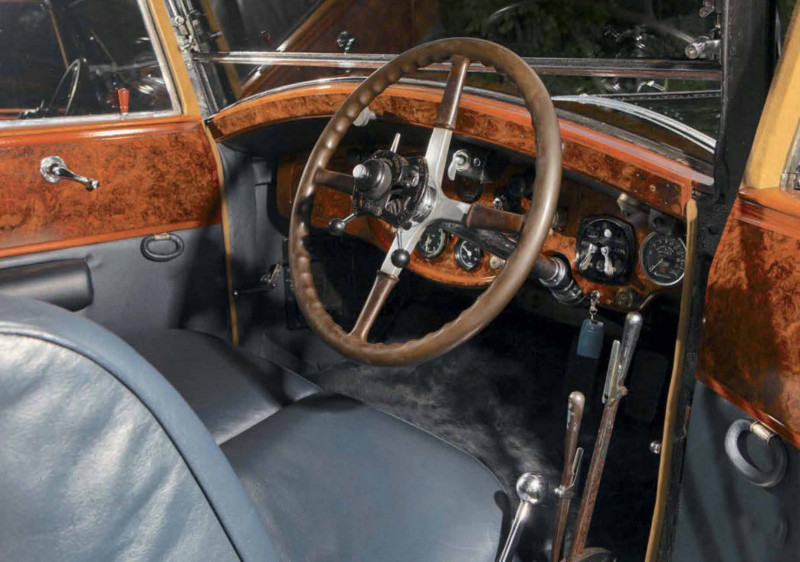
The striking blue finish becomes much less of a mystery when you learn that restoration work was entrusted to a chap whose day job was restoring Bugattis – ‘he probably had a lot of blue paint on the shelf,’ quips Chris, who set about getting it running properly after its 30 year hiatus. Most of the work was simple recommissioning, but the ammeter, a rare Weston Instruments 301, was badly broken, so you can imagine how pleased Chris was when he bumped into a stall holder at the Beaulieu Autojumble who had three of them. While working around the car Chris also discovered that the bumpers were original, after he found a plaque on them reading ‘Barker Coachworks.’
Back on the road, Chris uses the car for classic car events and last year went to the Vintage Sports Car Club’s annual gathering at Prescott Hillclimb. Walking back to the car he spotted a couple of people inspecting it and decided to hang back rather than interrupt them, but after a good 10 minutes had passed they clearly weren’t going anywhere, so he introduced himself. One of the chaps taking a keen interest in the Phantom turned out to be Rolls-Royce historian Tom Clarke, who confirmed that the bumpers Chris didn’t like were original, and later sent him a picture of the car when it was brand new, and featured in The Motor magazine. He also pointed out that headlights, also original, are unusual in that they’re French Marchal units rather than the more commonly fitted Lucas parts. They each contain three filaments, are dipped mechanically using a lever to the right of the driver’s seat and are known as Barker Dippers.
A HEFTY CHALLENGE
So what’s it like driving a 1929 Rolls- Royce? ‘Challenging’ is the first word that comes to Chris’s mind. In fact, when he first got the car up and running, he found it quite a struggle to pilot the beast. ‘Something about its shape is deceptive,’ he says, ‘and it doesn’t look as big as it is.’
Although, when parked next to Chris’ Silver Shadow the Phantom’s bulk becomes crystal clear. The Sports Limousine was intended for owners who wanted to drive the car themselves on occasion, so there’s more legroom in the front than would otherwise be the case. The partition between chauffeur and passengers in a standard limousine would slide, but in the Barker it winds down completely out of sight behind the front seats.
‘You simply can’t move the steering wheel when the car’s stationary,’ says Chris, ‘although once you’re on the move it’s fine.’ But the car wanders about on those vast crossplies, and there’s a lot more to keep you occupied other than simply remaining on the straight and narrow. Chris has plenty of experience with crash gearboxes, but that didn’t stop him struggling with this one. Then a friend told him to just treat it like a lorry gearbox, and he now gently blips the throttle on upshifts as well as downshifts, which has allowed him to finally master ratio changes between the four forward speeds. ‘But with nearly 8-litres on tap, there’s so much torque that it will very happily pull from 10 miles an hour in top.’

The 7668cc engine in this car has an alloy cylinder head spanning the two blocks of three cylinders (earlier cars had iron heads), and a compression ratio of just 5.5:1, so it’s unsurprising that it manages just 8-10mpg. Keeping it on song is no simple task either, with three controls mounted in the centre of the steering wheel that need adjustment – the top controls the mixture, the one on the left is the governor (idle speed control), while to the right sits the ignition advance and retard lever.
‘There’s a lot to think about when driving it, and it’s a very physical drive too, what with it wandering about,’ says Chris. ‘The first few times I drove it I found it incredibly tiring, but I’ve got the hang of it now.’
He says the four wheel brakes are very good, and they’re ably assisted by a mechanical servo driven from the gearbox via a clutch unit. It’s a clever system and works very well once properly adjusted, something Chris invested time in, having experienced just how well the setup can function on two 20/25s he previously owned. While the Phantom’s performance and road manners were exemplary in 1929, by modern standards the car is no magic carpet ride. ‘People imagine it’s like riding on air, but it really isn’t!’
He reckons a 1960s Mini is probably quieter and smoother (he should know, as he owns the oldest surviving Mini pick-up too) but he says he’s chased down most of the rattles now. Amusingly, the front bumper has little telescopic dampers, and you can loosen the bolts on it and swivel it upwards to shorten the car for ferry journeys. Chris’ work has paid off and the car is now starting properly, something it wouldn’t do when he got it. The Phantom has a separate Rolls-Royce built cold start carburettor, which was set completely incorrectly. ‘It starts instantly now,’ he says.
A REGIME OF CARE
Aside from being a demanding partner on the road, the Phantom’s maintenance requirements sound pretty much like a full-time job. There are 84 lubrication points, and tending to their needs is not far off a day’s work, using the purpose-made Enots oiler (filled with EP90) that screws on to each, once you’ve removed its cover. Some points are only accessible once you’ve taken the floorboards out, which is why Chris originally wanted a Phantom II, which was fitted with an automatic chassis lubrication system – one push and the job’s done.
Still, Chris’ perseverance has paid off as he says the car’s ride has improved immeasurably since his regular lubrication days, the leaf springs benefitting from being able to slide easily against each other. At one point he thought he might have to strip and rebuild them, but was advised to lubricate them with the oiler, then drive the car up and down a bumpy road – not hard to find these days. ‘I repeated this several times, and it’s amazing how much smoother and quieter the ride’s become over the 5000 miles I’ve done in the car.’
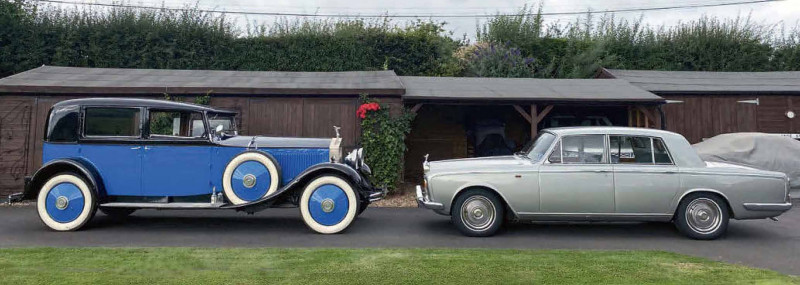
On top of the punishing chassis lubrication schedule Chris changes the engine oil every 500 miles or so just to make sure any sludge build-up from the 30 years it spent as a nonrunning museum exhibit can escape.
Oh, and the radiator is nickel not chrome, a more subtle finish but one that requires regular polishing. The mascot may be from a Phantom II, as it’s chrome, and Chris has a town cap which he fits when out and about in the car. The world famous Spirit of Ecstasy on this car is worth in excess of £1000, and he’d like to hang on to it. The cooling system itself holds seven gallons, and Chris reports that as a result, sitting in traffic in hot weather doesn’t bother the Phantom one bit, as long as you don’t forget to open the slats in the radiator grille, something that was thermostatically controlled on the Phantom II.
In this last year of production, Phantom engines had a spark plug on either side of the head (12 in total). On the offside they’re controlled by a coil and distributor ignition system, helped in this case by an electronic ignition unit made by Newtronic. Chris says it works well, so he’s leaving it in place for the time being. The plugs on the nearside of the car are sparked into life by a magneto, and there’s a switch inside the cabin to select either system, or both together. Quite why isn’t certain, but Chris thinks suspicions surrounding the reliability of the then new-fangled coil setup prompted Henry Royce to adopt a belt-and-braces approach.
Having discovered how amazingly original his Phantom is, Chris is keen to replace anything that isn’t correct, and has a replacement water temperature gauge ready to go on the car when he gets a chance, plus an Autovac to replace the currently fitted electric fuel pump.
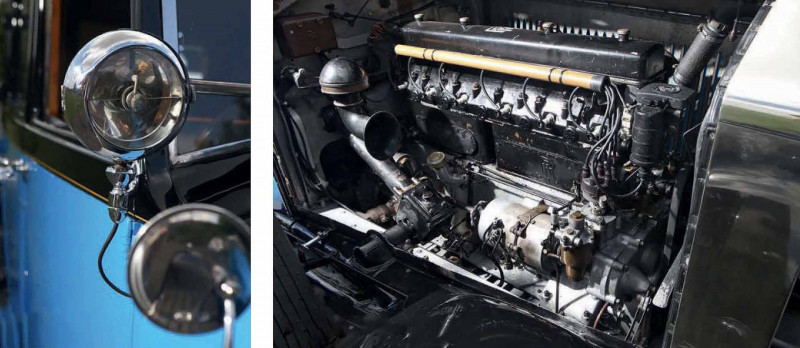
‘To be honest, we intended to do a Continental tour when we first got it,’ he says, ‘but the fuel consumption, plus worrying about bits disappearing from it when parked, put us off.’ All the same, he’s very happy with the Phantom now, and having finally mastered the art of proceeding smoothly in it, finds it immensely rewarding to drive. ‘The wandering is entirely what you would expect of a car of this era and type, and one of the greatest pleasures of owning and driving it is the sheer quality of the car, and how it is built.’ So for the time being Chris is happy to continue enjoying his Phantom on family days out, with his wife Lin next to him in the front. The Dachshunds? They travel in style on the posh seats behind.
ILL-GOTTEN GAINS

In 1926, Captain AC Bowles, a decorated army officer, was duped into becoming a frontman by the fraudster John Factor, brother of cosmetics entrepreneur Max. The pair launched various schemes including a magazine purporting to offer investment advice on stocks and shares, with Bowles and Factor buying shares cheaply, falsely inflating their value and selling them for a vast profit. Their takings were valued at around £600,000 when the case was discussed in The Times in 1931, which equates to around £9.5m today. The paper reported Bowles made perhaps £100,000 but gambled it away, and when the scandal broke Factor seemingly fled with the remainder, leaving Bowles holding the baby. He was cast in damages for the clients and declared bankrupt, owing £124,252 with assets of just £100. The surviving Rolls-Royce sales sheet shows Bowles at 10 Berkeley St. London W1, but at the bottom it says ‘Barkers advise sale df 30/11/28’. Could df mean deferred?

Whether the disgraced former war hero ever actually took delivery of the Phantom is unclear, but if he did, he only owned it for a couple of months at most. Even this photo offers a minor mystery: despite the WW2- era RAF uniform, we have found no evidence that Bowles ever served in the Air Force.
Luggage trunk provides ample storage. The propotions are so good you don't grasp the car's truly immense size. The four little dogs often come along for the ride, and must think they're Royalty. Progress can be rapid by 1929 standards, but you pay the price in petrol! Jump seats and a little cocktail cabinet await lucky passengers Armchair accommodation — despite four-light body, it's a true limousine.

Wheel discs and whitewalls give a jazz-age glamour.
Driver's compartment roomier and better-trimmed than a purely chauffeur-driven car. Don't forget your radiator shutter control — the slider on the right. Large wheel is necessary for hefty low-speed steering input.
A Silver Shadow is a large car, but a Phantom is larger.
Handsome spotlamp can be pointed by the driver. Coil and distributor ignition supplies this side's plugs; magneto the other. This Rolls-Royce has the kind of presence that can make even a church spire seem modest.


